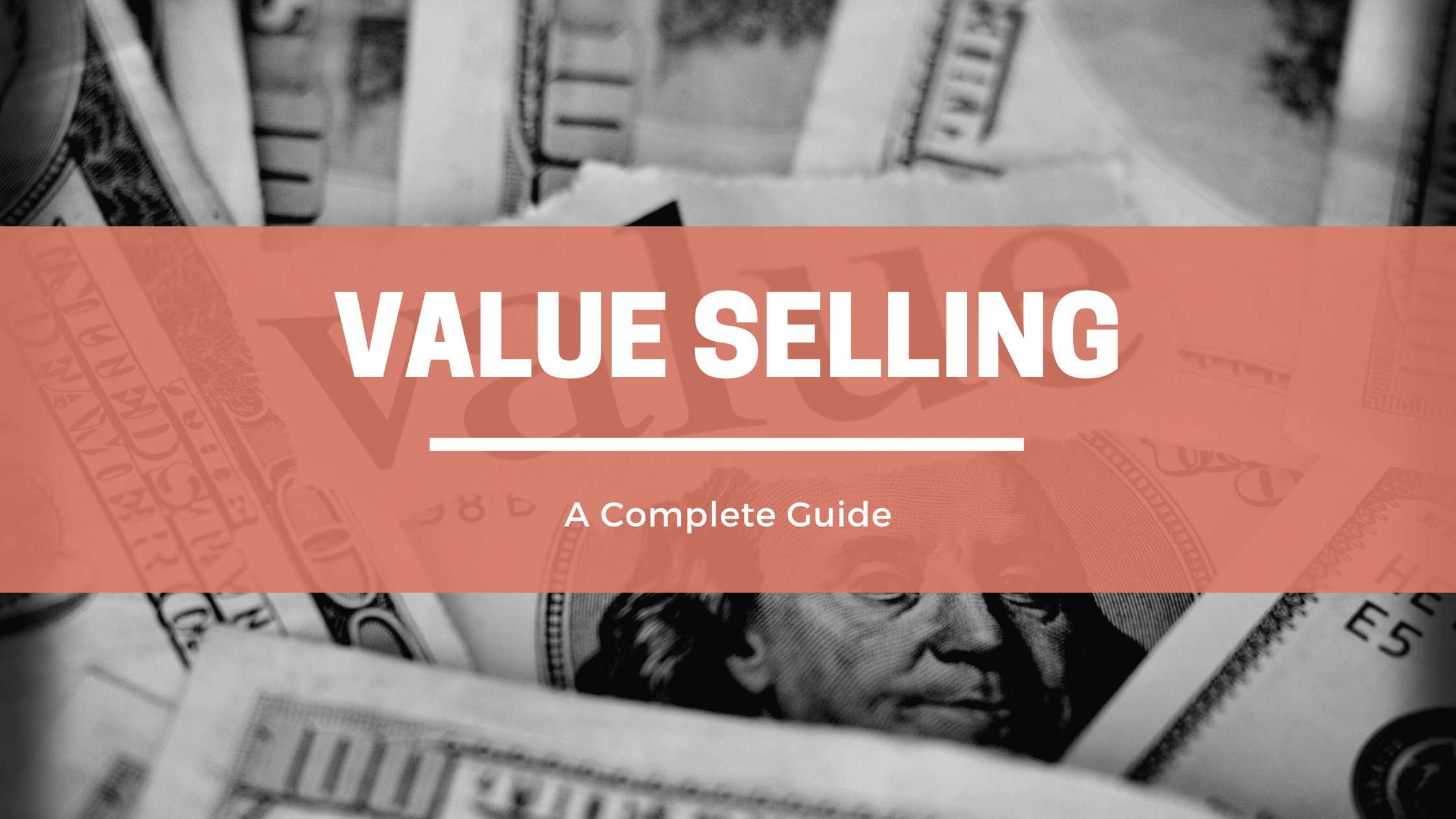In today’s competitive business environment, it’s more important than ever for companies to effectively communicate the value of their products and services to potential customers.
What is value selling ?
Value selling is a sales approach that focuses on highlighting the value that a product or service can bring to the customer, rather than simply focusing on the features or price of the offering. The goal of value selling is to help customers understand how the product or service will solve their problems, meet their needs, or improve their situation in a meaningful way.
What is value selling used for?
Value selling can be used in a variety of different contexts, including business-to-business (B2B) and business-to-consumer (B2C) sales, as well as in both online and offline sales environments. It is particularly effective when the customer is considering making a high-value or complex purchase, or when the product or service being sold offers significant benefits or value that may not be immediately apparent.
What is an example of value selling ?
An example of value selling might be a salesperson who is selling a software solution to a small business. Rather than simply describing the features of the software, the salesperson could focus on how the software can help the business streamline its operations, reduce costs, and improve efficiency, thereby providing a clear and tangible value to the customer.
What is the history of value selling ?
The concept of value selling has been around for many years, and it has evolved over time as sales techniques and strategies have developed. The basic idea of value selling is to help customers understand the value that a product or service can bring to them, and to focus on the benefits and advantages that the offering provides rather than just its features or price.
What is the importance of value selling ?
Value selling is important because it helps salespeople to connect with customers and build trust by demonstrating how the product or service can meet their needs and solve their problems. It also helps to differentiate the offering from competitors by highlighting its unique value proposition. By focusing on value, salespeople can often increase the perceived value of the product or service in the customer’s mind, which can lead to higher sales and customer satisfaction.
What is the benefit of value selling ?
The benefit of value selling is that it helps salespeople to effectively communicate the value of the product or service to customers, which can lead to increased sales and customer satisfaction. It can also help to build long-term relationships with customers by demonstrating the value that the product or service can bring over time. Ultimately, value selling can help businesses to differentiate themselves from their competitors and to build a loyal customer base.
What is the disadvantage of value selling ?
There are a few potential disadvantages to value selling:
- It requires a deep understanding of the customer’s needs and problems, as well as the product or service being sold. This can be time-consuming and may require salespeople to invest more effort into research and preparation.
- It can be challenging to quantify the value of the product or service in a way that is meaningful to the customer. This can be especially difficult when the value is intangible or difficult to measure.
- It may not be suitable for all products or services. Some offerings may be more commoditized or have fewer unique features, making it more difficult to differentiate them based on value.
What are the principles of value selling?
There are several principles that are typically associated with value selling:
- Understand the customer’s needs and problems: It is important to understand what the customer is trying to achieve and how the product or service can help them to do so.
- Focus on the benefits: Rather than just listing the features of the product or service, it is important to highlight the benefits that it provides to the customer.
- Quantify the value: Whenever possible, it is helpful to provide concrete examples or data to help the customer understand the value of the product or service.
- Differentiate the offering: It is important to help the customer understand how the product or service is unique and why it is a better choice than competing offerings.
What is value selling framework?
A value selling framework is a structured approach to value selling that helps salespeople to identify and communicate the value of a product or service to customers.
What are the steps for value selling ?
The steps for value selling may vary depending on the specific framework being used, but common steps include:
- Identify the customer’s needs and problems: This may involve asking questions, conducting research, or gathering information about the customer’s situation.
- Determine how the product or service can meet the customer’s needs: This may involve identifying the unique benefits and value of the product or service, and how it compares to competitors.
- Communicate the value: This may involve presenting the value proposition to the customer, using data and examples to support the argument.
- Address objections: It is important to be prepared to address any concerns or objections that the customer may have about the product or service.
- Close the sale: This may involve negotiating and finalizing the terms of the sale, and ensuring that the customer understands the value that they are getting from the product or service.
What is the decision process in value selling?
The decision process in value selling typically involves the customer evaluating the value of the product or service and determining whether it is worth the investment. This process may involve considering factors such as the cost, the benefits and features of the product or service, and any potential risks or drawbacks.
Is value selling still relevant?
Value selling is still relevant today because it helps salespeople to effectively communicate the value of a product or service to customers, which can lead to increased sales and customer satisfaction. It is particularly effective when the customer is considering making a high-value or complex purchase, or when the product or service being sold offers significant benefits or value that may not be immediately apparent. By focusing on value, salespeople can often increase the perceived value of the product or service in the customer’s mind, which can lead to higher sales and customer satisfaction.
What are value selling techniques?
There are a number of value selling techniques that salespeople can use to effectively communicate the value of a product or service to customers:
- Ask questions: Asking open-ended questions can help salespeople to better understand the customer’s needs and problems, and to identify how the product or service can meet those needs.
- Use storytelling: Telling stories about how the product or service has helped other customers can be a powerful way to communicate value.
- Use data and examples: Providing data and examples to support the value proposition can help to make it more concrete and believable.
- Highlight the unique value proposition: It is important to help the customer understand what makes the product or service different and why it is a better choice than competing offerings.
- Address objections: Being prepared to address any concerns or objections that the customer may have can help to build trust and demonstrate the value of the product or service.
Is value selling a skill?
Value selling is a skill that can be learned and developed over time.
What are the important skills to know in value selling?
Some of the important skills to know in value selling include:
- Communication: Being able to effectively communicate the value of the product or service to the customer is essential.
- Listening: It is important to listen to the customer’s needs and concerns in order to understand how the product or service can meet their needs.
- Problem-solving: Identifying how the product or service can solve the customer’s problems is a key part of value selling.
- Negotiation: Being able to negotiate and finalize the terms of the sale can be important in value selling.
How to learn value selling
There are a number of ways to learn value selling, including:
- Training programs: Many organizations offer training programs specifically designed to teach value selling skills.
- Books and online resources: There are many books and online resources available that can provide guidance and tips on value selling.
- Practice: The best way to improve value selling skills is through practice. This may involve role-playing or simulated sales situations, or working with a mentor or coach who can provide feedback and guidance.
- Experience: Gaining experience in sales and working with different types of customers can also help to improve value selling skills.
How to ask questions on value selling
To ask questions on value selling, it is important to focus on understanding the customer’s needs and problems, and how the product or service can meet those needs. Some examples of questions that may be helpful include:
- What are the biggest challenges or problems that you are facing right now?
- How does this product or service fit into your overall business goals?
- Can you give me an example of how this product or service has helped a customer in a similar situation?
- What specific benefits or value do you see this product or service providing for your business?
What is the difference between value and challenger selling?
Value selling is a sales approach that focuses on highlighting the value that a product or service can bring to the customer, while challenger selling is a sales approach that focuses on questioning and challenging the customer’s assumptions and beliefs about their needs and the products or services they are considering. Both approaches can be effective in different situations, but they are generally used in different contexts. Value selling is typically used when the customer is considering making a high-value or complex purchase, or when the product or service being sold offers significant benefits or value that may not be immediately apparent. Challenger selling, on the other hand, is typically used when the customer is stuck in a decision-making process, or when there are a lot of competing options available.

